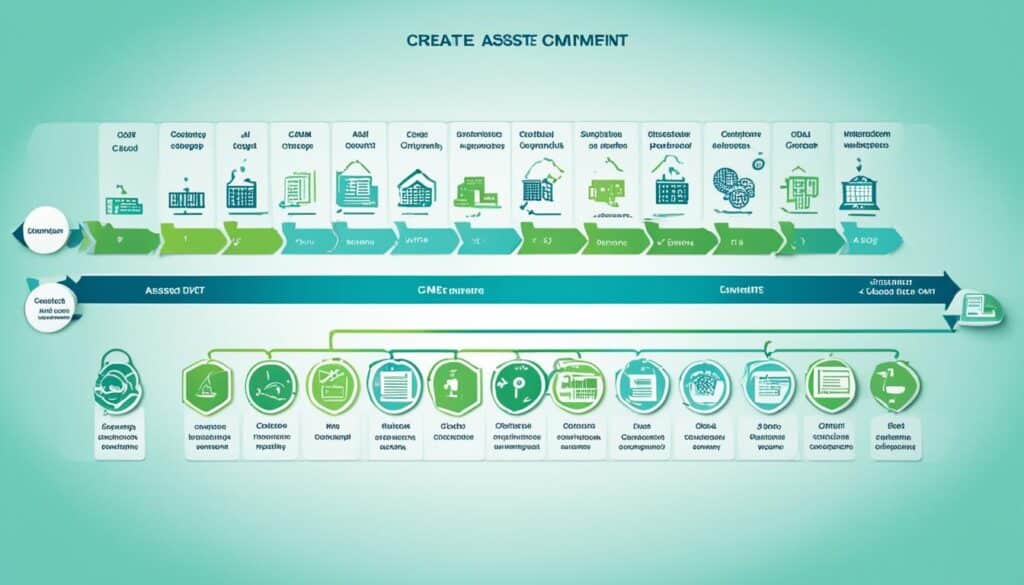In today’s dynamic IT environment, effectively managing IT assets is crucial for organizations to thrive. This guide will provide you with an in-depth understanding of asset management and CMDB, highlighting their roles and significance in managing IT assets within organizations in Singapore.
Asset management plays a vital role in tracking and managing physical assets within organizations. It focuses on activities such as inventory management, maintenance scheduling, and lifecycle analysis to ensure efficient and effective asset utilization in Singaporean enterprises.
On the other hand, CMDB is responsible for managing the configuration items of the IT infrastructure in Singapore. It acts as a centralized repository, providing a holistic view of the relationships and dependencies between various configuration items, including hardware, software, and network components.
Throughout this guide, we will delve into the details of asset management and CMDB, exploring their functions, objectives, and outcomes. We will also discuss the overlapping areas between these two systems, highlighting why both are essential for comprehensive IT asset management strategies in Singapore.
Stay tuned as we embark on this informative journey to gain a deeper understanding of asset management and CMDB, and how they contribute to effective IT asset management within organizations in Singapore.
Understanding Asset Management
Asset management is a vital process for tracking, maintaining, and optimizing physical assets within organizations in Singapore. It involves various activities such as inventory management, maintenance scheduling, and lifecycle analysis. The primary objective of asset management is to ensure the efficient and effective use of assets, reduce costs, and maximize their value in Singaporean enterprises.
By implementing asset management strategies, organizations can track the location, condition, and availability of their physical assets, enabling them to make informed decisions about their utilization. This includes monitoring asset maintenance needs, identifying potential risks or inefficiencies, and planning for asset upgrades or replacements. Asset management also facilitates compliance with regulatory requirements and enhances overall operational efficiency.
Effective asset management in Singaporean enterprises requires a systematic approach that integrates technology, processes, and people. By using asset management software and tools, organizations can streamline asset tracking and data management processes, enabling real-time insights into asset performance, usage, and value. This helps in making data-driven decisions and optimizing asset utilization across departments and locations within Singaporean enterprises.
Asset management plays a crucial role in diverse sectors such as manufacturing, healthcare, transportation, and logistics. For example, in the manufacturing industry, asset management ensures that production equipment is well-maintained, functioning optimally, and available when needed. Meanwhile, in the healthcare sector, asset management helps track and manage medical equipment, ensuring that healthcare providers have access to the necessary resources to deliver quality patient care.
With the increasing complexity of physical assets, such as IT infrastructure, vehicles, machinery, and buildings, asset management has become indispensable for organizations in Singapore. By implementing robust asset tracking and management practices, businesses can minimize asset downtime, reduce operational costs, and improve overall productivity in Singapore’s competitive market.
For asset-intensive industries operating in Singapore, such as oil and gas, utilities, and construction, effective asset management is even more critical. These industries require stringent asset tracking and maintenance strategies to ensure regulatory compliance, enhance safety measures, and optimize the performance of their physical assets. Asset management enables them to proactively identify issues, schedule timely maintenance, and extend the lifespan of their assets, resulting in cost savings and increased profitability.
In conclusion, asset management is a fundamental practice for organizations in Singapore, focusing on tracking, maintaining, and optimizing physical assets. By implementing effective asset management strategies, as well as using asset management software in Singapore, businesses can ensure the efficient use of assets, reduce costs, and maximize their value across different sectors. Whether it’s managing IT infrastructure, production equipment, or medical devices, asset management plays a significant role in Singaporean enterprises’ success.
Exploring CMDB
When it comes to managing the configuration items of your organization’s IT infrastructure in Singapore’s dynamic IT environment, having insight into what a Configuration Management Database (CMDB) is and its importance is crucial. A CMDB acts as a centralized repository, storing information about all the configuration items, including hardware, software, and network components.
By providing a comprehensive view of the relationships and dependencies between these configuration items, CMDB enables efficient and effective management of your IT assets in Singapore. It allows you to understand how various components are interconnected and how changes in one item can impact others, facilitating accurate configuration management.
In Singapore’s rapidly evolving IT landscape, where new technologies and systems are continuously being introduced, CMDB plays a vital role in ensuring the stability, security, and availability of your IT infrastructure. It contributes to proactive monitoring, effective change management, and streamlined IT service management processes.
With a CMDB in place, you gain better control over your IT assets, enabling you to optimize their usage, improve operational performance, and mitigate risks. Additionally, the comprehensive insights provided by CMDB help you make informed decisions regarding system upgrades, enhancements, and maintenance.
Overall, CMDB is an essential component of managing IT infrastructure’s configuration items in Singapore’s dynamic IT environment. By harnessing the power of CMDB, you can effectively manage your IT assets, enhance operational efficiency, and ensure the overall success of your organization.
Diving into the Differences
When it comes to managing IT assets within organizations in Singapore, asset management and Configuration Management Database (CMDB) have distinct functions, objectives, and outcomes. Let’s explore the details of each.
Asset Management
Asset management focuses on the tracking and optimization of physical assets. Its primary goal is to reduce costs, maximize asset value, and improve operational efficiency. Within Singaporean enterprises, asset management plays a crucial role in ensuring the effective use of resources and maintaining a competitive edge.
CMDB
On the other hand, CMDB is responsible for managing the configuration items of the IT infrastructure in Singapore’s dynamic IT environment. The CMDB serves as a centralized repository that holds valuable information regarding various components like hardware, software, and network infrastructure. Its objectives include accurate configuration management, enabling effective change management, and facilitating IT service management.
By having a comprehensive CMDB, organizations in Singapore can gain a holistic view of their IT infrastructure and make informed decisions regarding configuration changes and IT service delivery.
Here is a visual representation of the differences between asset management and CMDB:
As highlighted in the image, asset management focuses on physical asset tracking, while CMDB focuses on managing the configuration items and their relationships in the IT infrastructure.
Understanding these differences is crucial for organizations in Singapore to strategically implement asset management and CMDB to optimize their IT asset utilization, ensure accurate configuration management, and enhance operational efficiencies.
Identifying Similarities
In the realm of IT asset management in Singapore, there are overlapping areas between asset management and Configuration Management Database (CMDB). These areas of convergence provide valuable insights into how these two frameworks complement each other, resulting in a comprehensive IT asset management approach.
Both asset management and CMDB contribute to effective asset lifecycle management within organizations. Asset management ensures the optimal utilization and maintenance of physical assets, while CMDB focuses on managing the configuration items and their interdependencies in the IT infrastructure.
By incorporating both asset management and CMDB, organizations in Singapore gain a holistic view of their IT assets, enabling them to make informed decisions and enhance operational efficiency. The combination of these frameworks facilitates accurate tracking of assets, streamlines change management processes, and ensures compliance with regulatory requirements.
Recognizing the value of integrating asset management and CMDB is crucial for organizations in Singapore aiming to establish a robust and comprehensive IT asset management framework. The synergy between these frameworks facilitates seamless asset management, enhances decision-making processes, and ensures regulatory compliance.
Next, let’s explore further why both asset management and CMDB are essential components for comprehensive IT asset management strategies in Singapore.
The Necessity of Both Systems
When it comes to comprehensive IT asset management strategies in Singapore, incorporating both asset management and Configuration Management Database (CMDB) is essential. Asset management allows organizations to optimize the utilization of physical assets, ensuring they are efficiently tracked, maintained, and optimized. On the other hand, CMDB provides a holistic view of the IT infrastructure, enabling effective configuration management and facilitating accurate decision-making.
By integrating both asset management and CMDB systems, organizations can enhance asset visibility and improve operational efficiency. Asset management focuses on physical assets, such as hardware and equipment, ensuring their optimal utilization and maximizing their value. CMDB, on the other hand, manages the configuration items of the IT infrastructure, including hardware, software, and network components, allowing organizations to gain insights into the relationships and dependencies among these items.
This integration of asset management and CMDB enables organizations in Singapore to make informed decisions regarding their IT assets. By having a comprehensive understanding of their physical assets’ status and their configuration items’ relationships, organizations can proactively manage their assets, reduce costs, and ensure meaningful investments. Furthermore, this integration facilitates compliance with regulatory requirements, optimizes asset lifecycle management, and empowers organizations to adapt to the dynamic IT environment in Singapore.
In conclusion, comprehensive IT asset management strategies in Singapore must encompass both asset management and CMDB systems. By taking advantage of asset management’s focus on physical asset optimization and CMDB’s comprehensive view of the IT infrastructure, organizations can achieve enhanced asset visibility, improved operational efficiency, and informed decision-making regarding their IT assets.



































